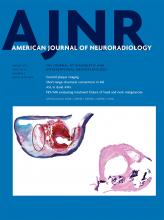I read with great interest the article by Darsaut et al1 on the evaluation of the accuracy of several transcranial Doppler (TCD) flow-velocity values in the diagnosis of severe angiographic vasospasm, which was defined as at least 50% reduction in the diameter of proximal intracranial arteries. In order to achieve this, they performed a retrospective analysis of 221 patients with aneurysmal subarachnoid hemorrhage (aSAH) who underwent TCD within 24 hours of conventional angiography and obtained mean flow-velocity threshold values of 164 cm/s for anterior circulation segments and 80 cm/s for the basilar artery (minimal sensitivity of 80% and specificity of 56%–71%). However, these relatively high-threshold values would still unnecessarily refer patients for cerebral angiography 50% of the time and still miss 10%–20% of patients with severe vasospasm, potentially leading to cerebral infarction.
I would like to share some thoughts that, hopefully, will add to the previously described results.
In patients with aSAH, a delayed phase of brain injury might take place due to delayed cerebral ischemia (DCI), which typically occurs between 3 to 14 days after ictus.2 Its pathophysiologic process is complex and still under scrutiny; however, it is hypothesized that it might build on a combination of angiographic vasospasm, microcirculatory dysfunction, microthromboembolism, cortical spreading depolarization/ischemia, and capillary transit time heterogeneity.2 Despite being one of the most widely evaluated parameters during follow-up after aSAH, angiographic vasospasm typically occurs in as many as 70% of patients, whereas DCI usually develops only in 30%.2
Given that decisions to perform rescue therapies, such as mechanical or chemical angioplasty, are usually based on TCD-obtained flow-velocity criteria (which are dependent on the degree of vasospasm), overtreatment (ie, due to false-positives) might occur. Therefore, not surprisingly, CTP has been assessed as a potential diagnostic tool to detect or even predict vasospastic infarction during the first 2 weeks after ictus (ie, vasospasm period).3 Because this technique assesses directly the brain parenchyma (ie, for ischemia or hypoperfusion), it has the potential to reduce the aforementioned overtreatment of patients with aSAH diagnosed with vasospasm. With this concept in mind, it has been shown that whole-brain CTP performed on day 3 after ictus has sufficient diagnostic accuracy to identify patients at risk for DCI, allowing intensification of antivasospastic therapy.3
In a more recent study,4 the authors suggested a standardized CTP protocol for the management of patients with aSAH after finding significantly better outcomes (ie, mRS at 3 months) in patients in whom such protocol was followed compared with another group in which CTP was performed on an individual basis (ie, in a nonstandardized approach). This protocol would potentially reduce excessive radiation exposure by triaging patients on the basis of a daily neurologic assessment and TCD measurement; only comatose and/or sedated patients would systematically undergo CTP at days 3–5, with cases with neurologic deterioration or TCD criteria of vasospasm undergoing CTP on demand. Thus, CTP seems to have the potential to be the main imaging diagnostic tool in the follow-up of patients with aSAH, with TCD having a complementary role in the triage of such patients (mainly based on rising serial values and less on an absolute single one).
Footnotes
Disclosure forms provided by the authors are available with the full text and PDF of this article at www.ajnr.org.
- © 2022 by American Journal of Neuroradiology












